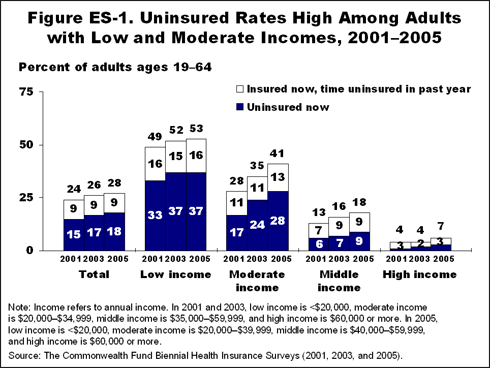|
Over 45 million Americans under age 65 lacked health insurance coverage in 2004, an increase of 800,000 in a single year and over six million people since 2000. While the majority of Americans obtain health insurance through their employer as a benefit, being employed does not guarantee that a worker will have insurance. The uninsured come primarily from working families with low and moderate incomes, families for whom coverage is not available in the workplace or is unaffordable. Medicare covers virtually all those 65 and older, while Medicaid and the State Children’s Health Insurance Program (S-CHIP) help provide coverage for millions of low-income people. However, there still remains a significant gap in coverage—so large that 18% of the population under age 65 lacks health insurance. Employer-sponsored health insurance, sensitive to both the general economy and changes in health insurance premiums, has decreased markedly from covering 66% of the nonelderly in 2000 to 61% by 2004.
There is a strong relationship between health insurance coverage and access to medical services. Health insurance makes a substantial difference in the amount and kind of health care people are able to afford, as well as where they obtain care. Research has consistently shown that the lack of insurance ultimately compromises persons’ health because they are less likely to receive preventive care, are more likely to be hospitalized for avoidable health problems, and are more likely to be diagnosed in the late stages of disease. Having insurance improves health overall and could reduce mortality rates for the uninsured by 10 to 15%. Health insurance also affects the financial well-being of families. Insurance helps reduce the financial uncertainty associated with health care.
Medicaid and the S-CHIP provide coverage to certain low-income populations that meet eligibility requirements. The programs play a particularly important role for children, aiming to cover nearly all low-income uninsured children. The role of Medicaid for adults is far more limited however, covering only some low-income parents and disabled individuals, leaving most childless adults ineligible, regardless of how poor they are. Recent growth in Medicaid and S-CHIP enrollment of children has filled in the sizable gap created by decreased employer-sponsored insurance since 2000. The share of children who are uninsured actually decreased between 2000 and 2004, but little progress was made in expanding public insurance to more low-income adults. Consequently, adults accounted for all of the growth in the number of uninsured since 2000.

Source: Kaiser Commission on Medicaid and the Uninsured and The Commonwealth Fund .
|

